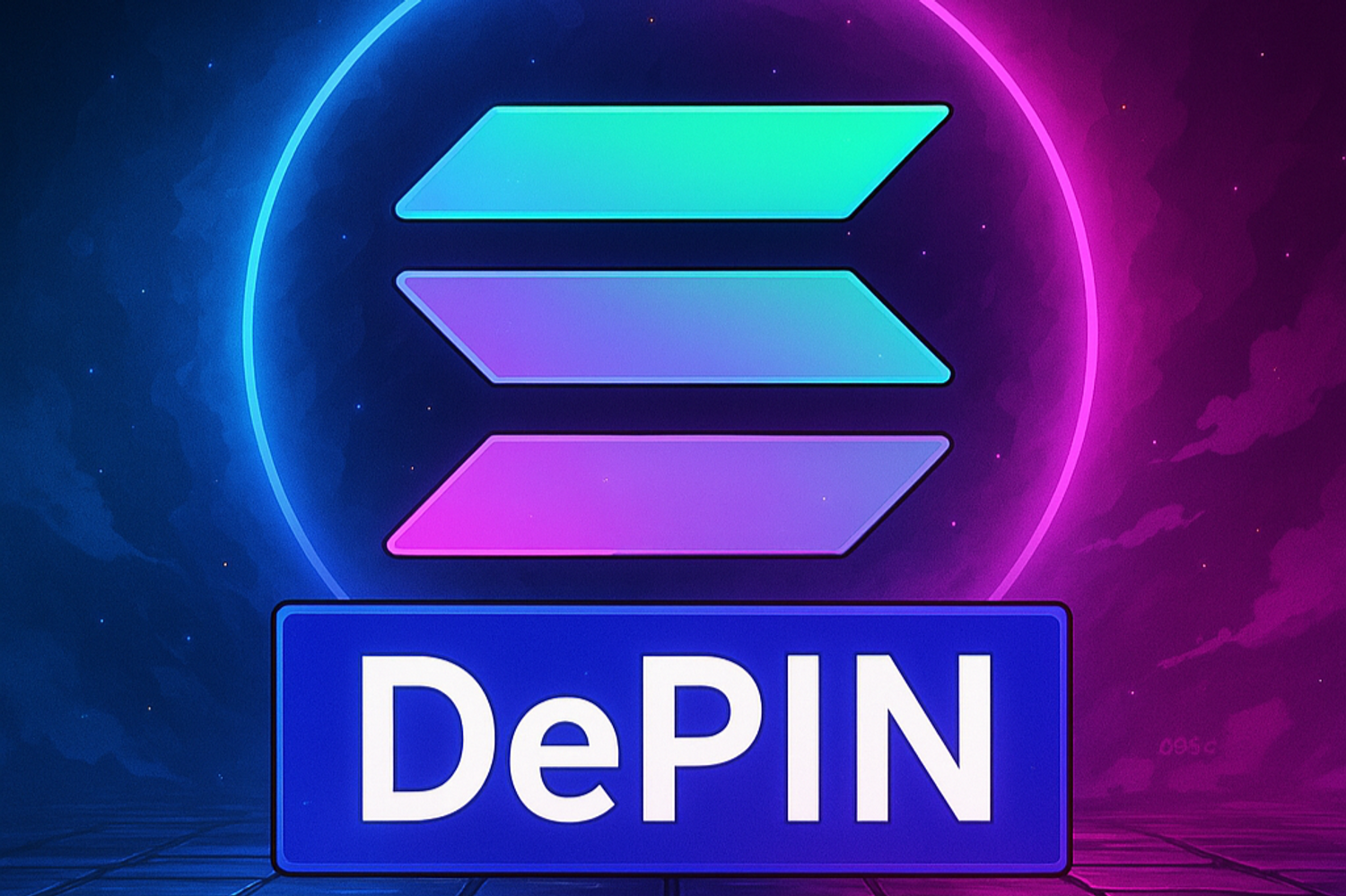
DePIN on Solana: A Data-Driven Analysis of Revenue, Contributors, and Rewards
Exploring the Performance and Potential of Decentralized Infrastructure Projects on Solana
- Published: Mar 31, 2025 at 16:31
- Edited: May 19, 2025 at 13:39
The decentralized physical infrastructure network (DePIN) sector has found a fertile home on the Solana blockchain due to its high speed, scalability, and low transaction costs. DePIN projects leverage blockchain to build tangible infrastructure such as wireless networks, distributed computing, and data collection platforms.
In this analysis, we'll explore the recent onchain trends of leading DePIN projects on Solana.
Revenue Trends: Peaks and Declines
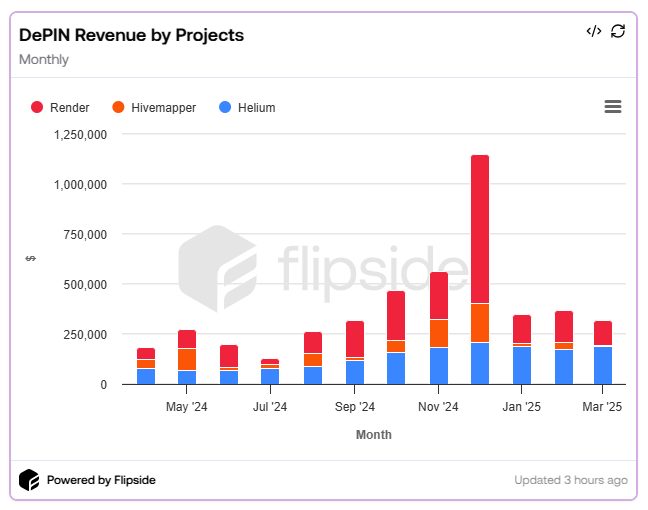 Based on Flipside data, December 2024 marked an impressive peak for DePIN projects on Solana. Collectively, Helium, Render, and Hivemapper reached a record monthly revenue of over $1.14 million.
Based on Flipside data, December 2024 marked an impressive peak for DePIN projects on Solana. Collectively, Helium, Render, and Hivemapper reached a record monthly revenue of over $1.14 million.
Render was the standout, contributing approximately 65% ($746K), driven by significant usage in decentralized GPU computing. Helium and Hivemapper accounted for the remaining share, with approximately 18% ($206K) and 17% ($195K), respectively.
However, the beginning of 2025 revealed a sharp downturn. Render experienced the most significant decline, dropping by roughly 80% to just $145K in January and declining further to around $122K by March. This drop indicates the volatility associated with project-based demand, particularly in fields like GPU computing.
Hivemapper faced an even steeper decline, with revenue plunging nearly 94%, from $195K in December to under $12K in January and further down to approximately $6K by March.
In contrast, Helium Mobile displayed remarkable resilience, maintaining stable revenues above $188K in March 2025, with minimal variance from its December peak. This stability reflects Helium's diversified use cases, notably IoT and cellular data offloading, providing ongoing and tangible real-world utility.
Contributor Growth: Diverse Dynamics
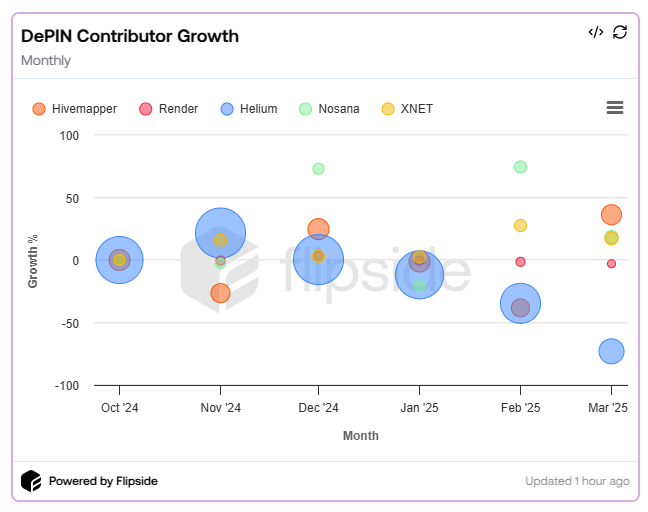 Examining contributor trends reveals varied trajectories across these DePIN networks. Helium Mobile has historically held the largest contributor base but recently experienced declining participation. After a brief spike of 21.6% in November, Helium faced a steep 73% reduction in active contributors between February and March 2025.
Examining contributor trends reveals varied trajectories across these DePIN networks. Helium Mobile has historically held the largest contributor base but recently experienced declining participation. After a brief spike of 21.6% in November, Helium faced a steep 73% reduction in active contributors between February and March 2025.
Render showed a much milder contributor decline of about 3% in March, suggesting greater community resilience despite revenue volatility. On the positive side, several other projects recorded growth:
-
Hivemapper grew contributors by 36.2%, driven by enthusiasm around new hardware.
-
Nosana and XNET saw increases of 18.3% and 17.3%, respectively.
Rewards Per Contributor: Evaluating Incentives
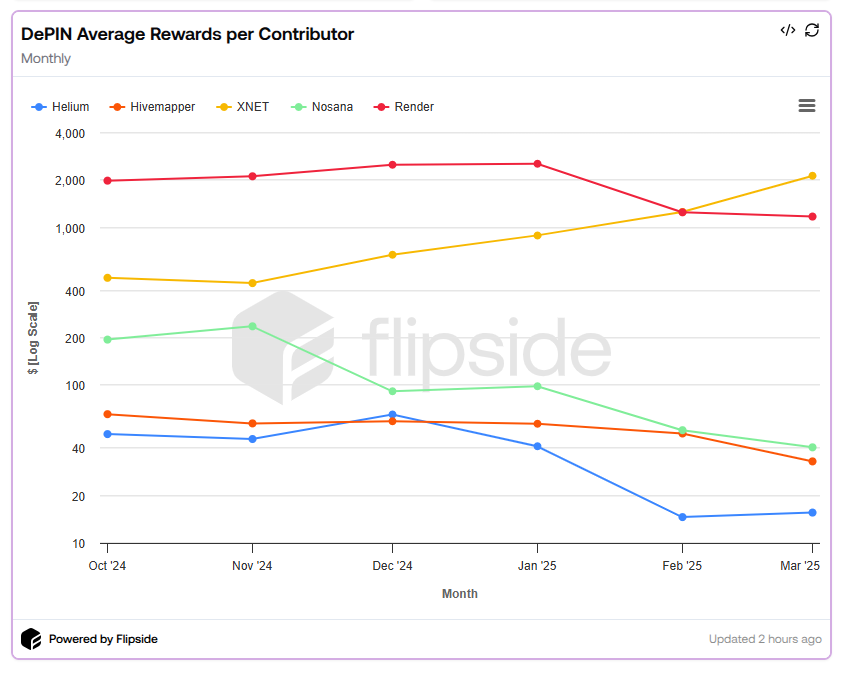 The average reward per contributor is a critical indicator of community sustainability. XNET leads in this metric, with average rewards surging to $2,143, a significant 70% increase compared to the previous month. XNET's impressive growth in rewards aligns with increased data offloading, reflecting robust real-world adoption and tokenomics.
The average reward per contributor is a critical indicator of community sustainability. XNET leads in this metric, with average rewards surging to $2,143, a significant 70% increase compared to the previous month. XNET's impressive growth in rewards aligns with increased data offloading, reflecting robust real-world adoption and tokenomics.
Helium Mobile also experienced modest reward growth (6.8%), with an average payout of $15.6 per contributor, illustrating its stable reward structure despite reduced contributor numbers.
However, Render, Nosana, and Hivemapper saw declines in average rewards, driven largely by revenue drops and diluted reward pools from expanded contributor bases.
Project Spotlights: Key Insights from OnChain Data
XNET
XNET operates as a decentralized communication network providing LTE, 5G, and Wi-Fi offloading services. Since migrating from Polygon to Solana in August 2024, XNET has experienced notable growth.
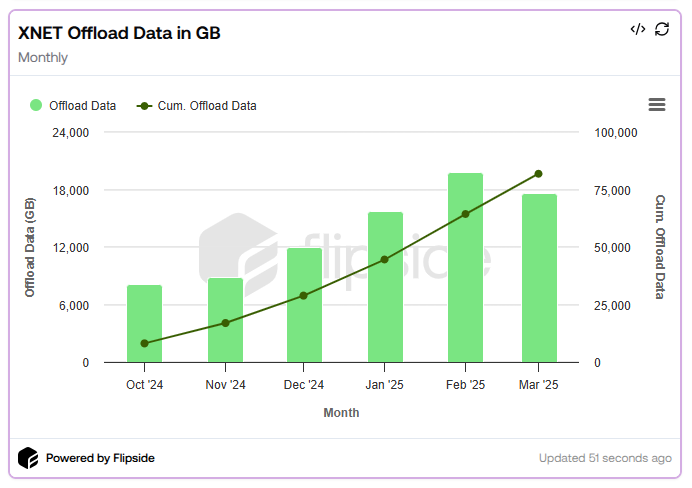 In February 2025, XNET offloaded over 19,760 GB, marking a 26% month-over-month increase, although March saw a slight 12% pullback.
In February 2025, XNET offloaded over 19,760 GB, marking a 26% month-over-month increase, although March saw a slight 12% pullback.
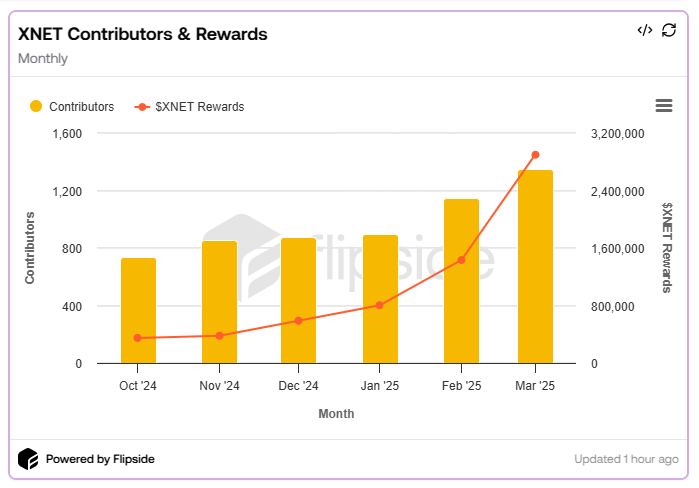 With steady contributor growth, reaching 1,344 in March, and total monthly rewards exceeding 2.89 million $XNET tokens, the platform shows strong momentum.
With steady contributor growth, reaching 1,344 in March, and total monthly rewards exceeding 2.89 million $XNET tokens, the platform shows strong momentum.
Helium Mobile
Helium Mobile, part of the broader Helium ecosystem, has capitalized on the migration to Solana by significantly expanding its decentralized wireless network.
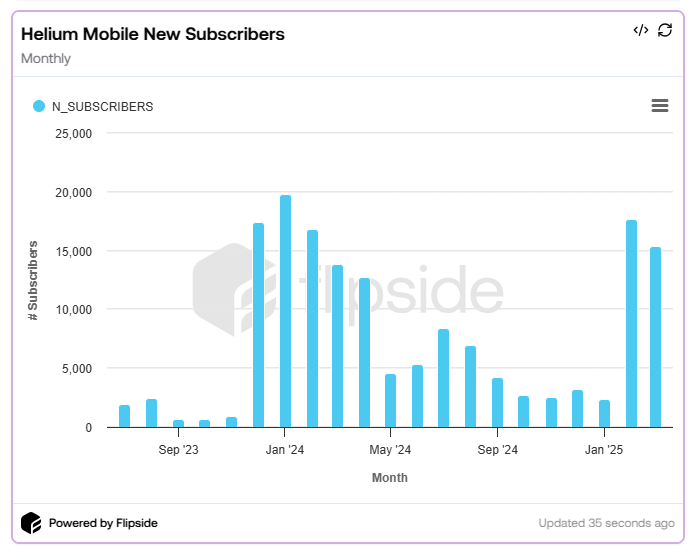 Despite fluctuating contributor counts, its subscriber base grew notably, with over 32,900 new subscribers in early 2025 alone. March saw the deployment of 1,432 new hotspots, reflecting continued network expansion, albeit with some recent slowdown.
Despite fluctuating contributor counts, its subscriber base grew notably, with over 32,900 new subscribers in early 2025 alone. March saw the deployment of 1,432 new hotspots, reflecting continued network expansion, albeit with some recent slowdown.
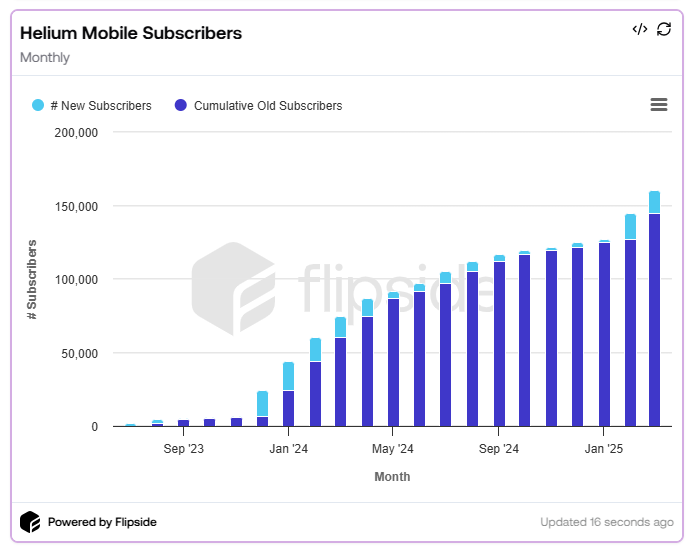 Helium Mobile currently has over 160,000 subscribers, representing a 115% increase from March of last year.
Helium Mobile currently has over 160,000 subscribers, representing a 115% increase from March of last year.
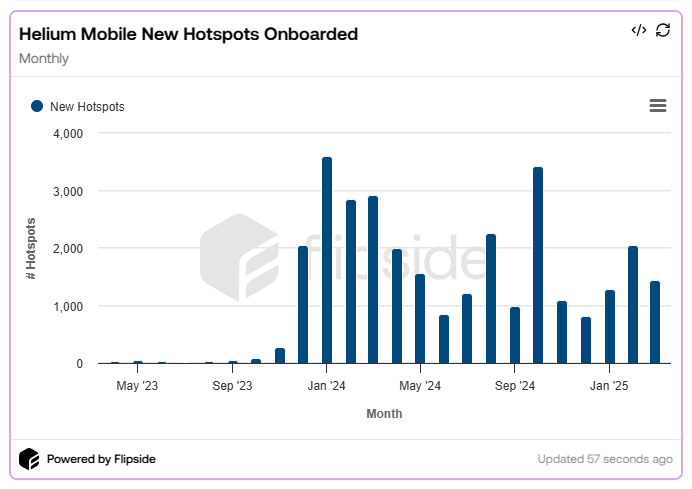 In March, 1,432 new hotspots were deployed, which is a 30% drop from February. However, February had recorded the highest number of deployments in the past three months, with a 60% increase compared to January.
In March, 1,432 new hotspots were deployed, which is a 30% drop from February. However, February had recorded the highest number of deployments in the past three months, with a 60% increase compared to January.
Roam
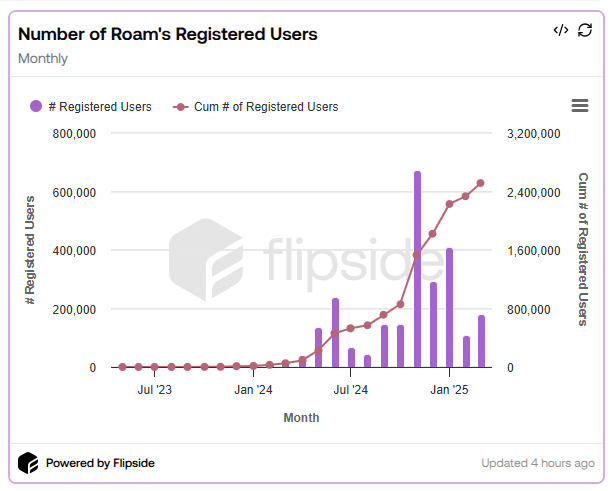 Roam, a decentralized Wi-Fi and eSIM connectivity provider, saw explosive growth with over 672,000 new users in November 2024. Despite a downturn afterward, March 2025 recorded a strong recovery, posting a 70% growth in new user registrations.
Roam, a decentralized Wi-Fi and eSIM connectivity provider, saw explosive growth with over 672,000 new users in November 2024. Despite a downturn afterward, March 2025 recorded a strong recovery, posting a 70% growth in new user registrations.
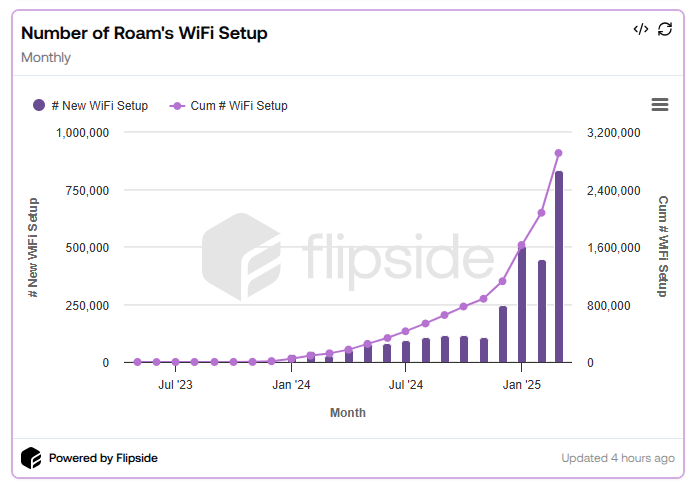 WiFi installations hit a remarkable milestone, with over 951,000 setups in March alone, indicating Roam's successful user engagement strategies and infrastructure scaling.
WiFi installations hit a remarkable milestone, with over 951,000 setups in March alone, indicating Roam's successful user engagement strategies and infrastructure scaling.
NATIX
NATIX focuses on decentralized geospatial data collection, leveraging user-operated cameras for urban analytics and autonomous driving applications.
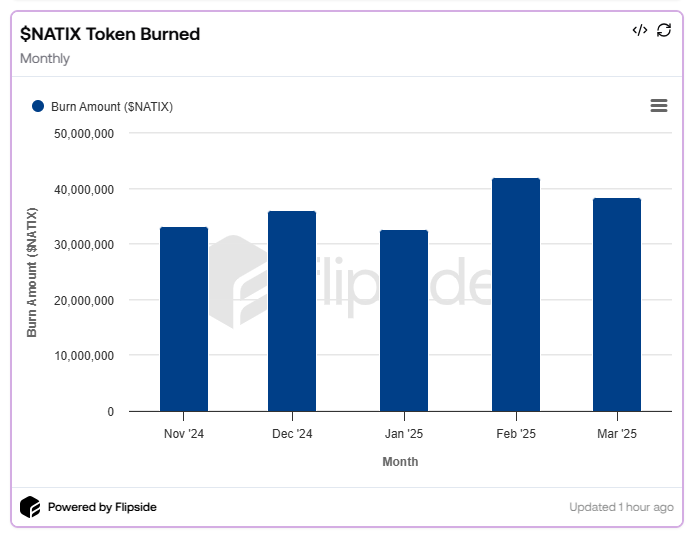 The project achieved significant token burn rates, setting a record of over 41.9 million $NATIX in February due to heightened data demand. Although March showed an 8.5% decline, NATIX’s increasing enterprise adoption positions it favorably within the decentralized data market.
The project achieved significant token burn rates, setting a record of over 41.9 million $NATIX in February due to heightened data demand. Although March showed an 8.5% decline, NATIX’s increasing enterprise adoption positions it favorably within the decentralized data market.
Hivemapper
Hivemapper's decentralized mapping network invites contributors to collect and sell mapping data through dashcams.
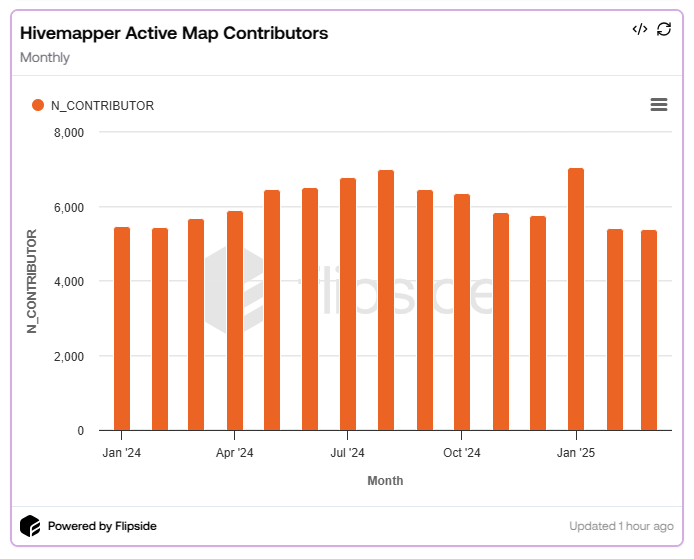 After hitting peak contributor numbers (7,040) in January 2025, driven by new hardware releases, numbers stabilized at around 5,378 contributors in March.
After hitting peak contributor numbers (7,040) in January 2025, driven by new hardware releases, numbers stabilized at around 5,378 contributors in March.
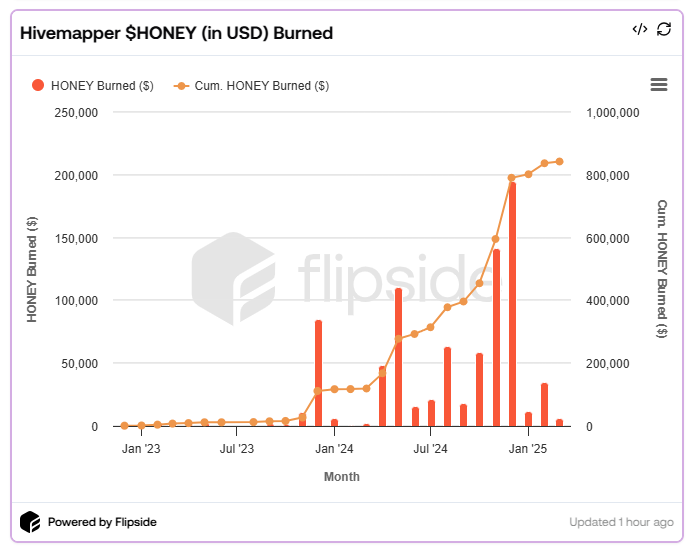 Hivemapper experienced its highest token burn growth in late 2024, with over $195,000 worth of $HONEY burned in December alone. However, since early 2025, this figure has significantly declined, accompanied by a decrease in contributor earnings.
Hivemapper experienced its highest token burn growth in late 2024, with over $195,000 worth of $HONEY burned in December alone. However, since early 2025, this figure has significantly declined, accompanied by a decrease in contributor earnings.
Render
Render has emerged as a prominent decentralized GPU computing provider, extensively benefiting from Solana's infrastructure.
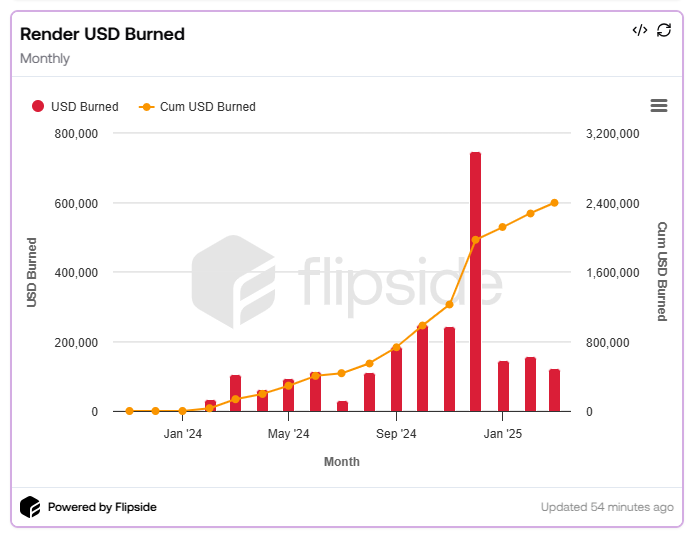 Despite a revenue peak of $746K in December 2024, the subsequent steep decline (80%) highlights the project's exposure to market cycles. Render’s recent pivot toward AI workloads and other compute-intensive applications may smooth future revenue streams, indicating adaptive strategies to secure long-term sustainability.
Despite a revenue peak of $746K in December 2024, the subsequent steep decline (80%) highlights the project's exposure to market cycles. Render’s recent pivot toward AI workloads and other compute-intensive applications may smooth future revenue streams, indicating adaptive strategies to secure long-term sustainability.
Nosana
Nosana specializes in decentralized GPU computing, particularly targeting AI and machine learning applications.
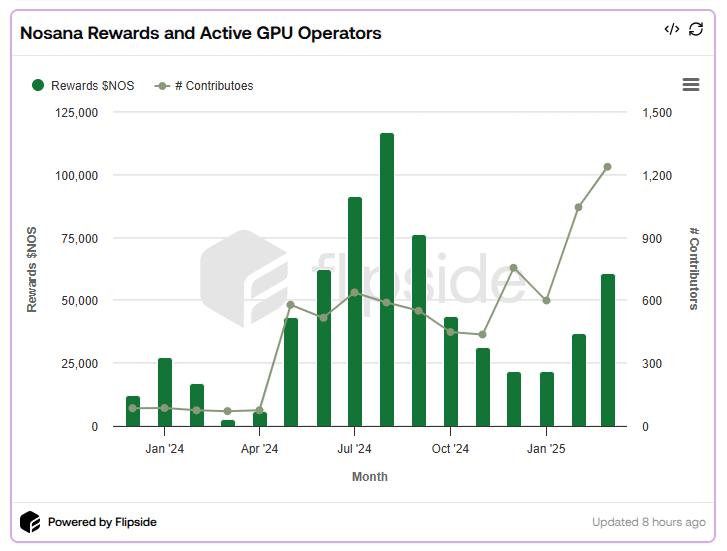 Nosana has 1,239 active contributors as of March 2025, representing an 18.5% increase from February and reflecting steady community growth. During March, these contributors earned over 60,000 $NOS in rewards.
Nosana has 1,239 active contributors as of March 2025, representing an 18.5% increase from February and reflecting steady community growth. During March, these contributors earned over 60,000 $NOS in rewards.
 Jobs completion metrics reinforce this trend, with over 119,000 jobs executed in March alone—a 53% increase since January. This sustained contributor activity and increasing job demand suggest Nosana’s growing viability as an alternative to centralized cloud computing.
Jobs completion metrics reinforce this trend, with over 119,000 jobs executed in March alone—a 53% increase since January. This sustained contributor activity and increasing job demand suggest Nosana’s growing viability as an alternative to centralized cloud computing.
Final Thoughts
Onchain data from these DePIN projects demonstrates significant volatility alongside promising innovation. Projects such as Helium Mobile and XNET illustrate robust revenue and community dynamics, highlighting potential pathways toward sustainable growth. Conversely, dramatic fluctuations in Render and Hivemapper emphasize ongoing challenges within this nascent sector.
Overall, Solana’s efficient blockchain infrastructure continues to underpin DePIN innovation, enabling projects to experiment rapidly and scale effectively. Despite near-term fluctuations, long-term adoption driven by real-world utility, user engagement, and strategic partnerships will likely define sustainable success in this exciting segment of blockchain technology.
This piece is part of our Solana Data Insights series. Make sure to subscribe to Solana Data Insights for weekly onchain analysis.
Read More on SolanaFloor:
Metaplex Creates ~3x More Tokens than Ethereum + L2s Combined in March

